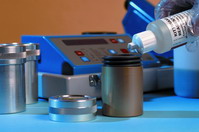 Implementing an oil analysis sampling frequency strategy is fundamentally an identical process whatever the industry. However, this leads to the perception that the implementation is a
Implementing an oil analysis sampling frequency strategy is fundamentally an identical process whatever the industry. However, this leads to the perception that the implementation is a
Historically, there have been conflicting views as to sampling frequency, driven, in part, by commercial agendas. A ‘free’ sampling programme will unlikely offer anything more frequent than twice a year per machine. This is undermining the true value of oil analysis. Effective, proactive oil analysis is about making an informed judgement on your machine and what action to take, if any to avoid the onset of failure.
There are two aspects to consider with sampling, that of routine, and that of abnormal. Proactive is much more a routine issue, looking to ensure that all known root cause parameters (contamination and oil health) are controlled to avoid the onset of failure or a reduction in potential service life. The frequency of this is down to the criticality of the unit, the fluid environment, the age of the lubricant and machine, and how tight a proactive target is set upon the value being measured. And, this frequency may be variable depending on the aforementioned factors. Essentially, a predictive focus should follow an alarm triggered in routine, proactive testing, and is geared towards looking for and understanding the signs of impending failure, which may mean a shift to more frequent and complex sampling agendas to monitor the deterioration of the unit, hence an abnormal situation.
Routine sampling is generally a simple test menu at much lower cost allowing greater frequency, whilst abnormal conditions require a more costly, complex test. Fortunately, in a proactive environment, the occurrence of abnormal conditions will be far less frequent than under a predictive maintenance regime, since the very action of being proactive ensures a healthy plant. So the economics balance out, especially if the proactive information is acted on immediately.
Setting frequencies in the design stage, using a ‘frequency generator table’, will then dictate the tools and services required to achieve success in lubrication and maintenance through oil analysis. To illustrate, for reasons of severe safety, criticality of process and the economic penalty of machine failure then the calculated sampling interval is such that online, real-time monitoring is required. However, at the other extreme of sampling interval, a commercial laboratory service will suffice. Somewhere in between, there is the possibility of using on-site tools since this brings a balance between the cost of applying online tools on all systems, against paying shipping and service costs for frequent sampling.
In reality, the use of on-site tools for the screening of particle counts, viscosity, moisture and acid numbers does allow for more frequent sampling in any case, since once purchased, these tools prove very cost effective, and allow the savings to be set against quality analysis on exceptional samples. Bear in mind that baseline samples of new oil should still be sent into the laboratory for reference, and should be backed up with at least a six monthly sample for in-depth routine checks beyond the on-site analysis.
To many, truly effective sampling intervals seem ridiculously tight compared to historical programmes. Forget historical. A proactive strategy requires frequent analysis to check for root cause conditions. Predictive programmes look for signs of impending wear out. That can happen over a longer period, and other early warning indicators often apply. Unfortunately, a filter failure, or a coolant leak can happen instantaneously, and if left unnoticed over a three-month period will cause significant damage and severely reduce the useful life of the machine. When spotted immediately with frequent sampling, and, if rectification is swift, then minimal damage is suffered by the machine.
Remember, oil analysis alone does not bring reliability, it is the information it offers and how that is acted on that counts. And that means having effective targets, limits and sampling frequencies in place.
For more information on the range of oil analysis tools, visit
For further information contact:
Paul Froome
Marketing Manager
Kittiwake Developments Ltd
Email: This email address is being protected from spambots. You need JavaScript enabled to view it.
Tel: +44 (0) 1903 731470
Fax: +44 (0) 1903 731480
Author: Martin Williamson, BSc CMRP MLA1 MLT1
KEW Engineering Ltd,
Tel: 01244 683331
email: This email address is being protected from spambots. You need JavaScript enabled to view it.
web site: www.kewengineering.co.uk
Website: http://www.kittiwake.com

